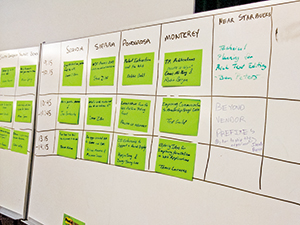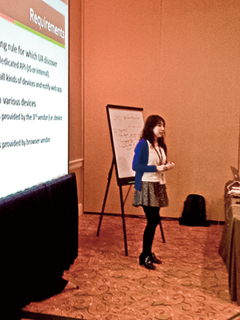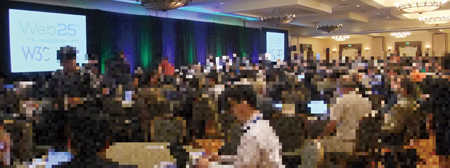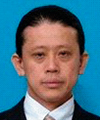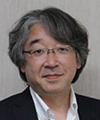 |
|||||||||||
|
|
|||||||||||
|
Global Standardization Activities Vol. 13, No. 5, pp. 39–44, May 2015. https://doi.org/10.53829/ntr201505gls W3C TPAC 2014 Report and HTML5 RecommendationAbstractThe W3C (World Wide Web Consortium) Technical Plenary / Advisory Committee Meetings Week (TPAC) was held from October 27 to 31, 2014, in Silicon Valley in the USA. The year 2014 was not only the 25th anniversary of the creation of the web but also the 20th anniversary of the foundation of W3C. On October 28, the W3C published a formal Recommendation of HTML5 (HyperText Markup Language, fifth revision) during TPAC in this anniversary year. In this article, we report on W3C TPAC 2014 and the HTML5 Recommendation. Keywords: W3C, TPAC, HTML5 1. IntroductionThe World Wide Web Consortium (W3C), founded by Sir Tim Berners-Lee, is a nonprofit standardization community that develops web standards. The number of member companies and organizations was 402 as of December 2014; NTT has been a W3C member since December 1995. The W3C develops well-known standards such as those for HTML (HyperText Markup Language) and CSS (Cascading Style Sheets), and its published standards are open and freely available to the public. One of the recent hot topics in W3C is the standardization of several JavaScript application programming interfaces (APIs), which are implemented in web browsers to enhance the power of web applications. One of the characteristics of the standardization process in the W3C (Fig. 1) is that it is tightly coupled with the implementation. For example, the call for the implementation to browser vendors and the preparation of test suites are mandatory at the stage of the Candidate Recommendation, so feedback on ambiguous points and on problems with specifications is given at this stage. As a result, in many cases, W3C standards are already available and in wide use in the web when they reach the W3C Recommendation stage.
2. W3C TPAC 2014 reportThe Technical Plenary / Advisory Committee Meetings Week (TPAC) is the W3C’s annual general meeting held around November every year. Face-to-face meetings are held for not only the Working Groups (WGs) but also the Advisory Committee (AC), which consists of representatives of member organizations and mainly discusses the management policies of W3C. A large number of people attended TPAC 2014 because 2014 was the anniversary of the creation of the web and W3C. The schedule of TPAC 2014, which lasted five days, was consistent with past TPAC events in that the first and last two days were reserved for WG and AC discussions. On October 29, the third and middle day of TPAC, breakout sessions were held from morning to afternoon (Photo 1). The presenters were selected from TPAC participants, and they managed and moderated discussions on issues that would be important in W3C in the near future, so there were active exchanges of opinions in many sessions. On the same day, a plenary anniversary symposium, titled The Future of the Web, was held from afternoon to early evening. In this section, we report on some items of interest from TPAC 2014 that are related to NTT.
2.1 Advisory BoardThe Advisory Board (AB) is an organization that provides ongoing guidance to the W3C on issues of strategy, management, legal matters, and the standardization process. In July 2014, Mr. Jay (Junichi) Kishigami, a senior advisor at NTT, became one of the nine members of the AB and the second Japanese member. He attended the face-to-face AB meeting at TPAC 2014 and actively discussed the future of the web and W3C. 2.2 Web and TV IGStandardization activities focusing on particular industry fields are also carried out by W3C, and the broadcasting field is one of them. One of the representative services that integrates the web and broadcasting is smart TV (television). The Web and TV Interest Group (IG) that comprises telecommunications carriers, broadcasting organizations, manufacturers, and browser vendors discusses requirements and use cases for the future smart TV [1]. NTT has been actively participating in the Web and TV IG since its establishment and is particularly interested in the development of IPTV (Internet protocol TV). The Web and TV IG also serves as a forum for introducing methods for integrating the web and broadcasting such as Hybridcast, which was developed in Japan, and HbbTV, which is mainly used in Europe, and for sharing problems among IG members. At TPAC 2014, NHK of Japan introduced Hybridcast2.0, which covers the exact synchronization of time between broadcasting and IP communications. 2.3 NTT Communications activity for the WoTNTT Communications has been paying attention to and working on the new technology called the Web of Things (WoT), which enhances the potential of the web. The concept of WoT is to realize various new use cases by connecting people and devices, or devices and devices. One example of the WoT is Chromecast, a small-sized media-streaming device developed by Google Inc. that has been available in Japan since May 2014. This device can seamlessly connect people and devices via a web browser. For example, a movie played in a smartphone can be easily transferred to a large screen TV in a living room. Another example is the AirPlay API by Apple Inc., which realizes the same feature using the web browser in the iPhone. Although in the present circumstances, these technologies were developed independently by individual companies, a discussion about combining them as the Presentation API [2] has begun in the Second Screen Presentation Community Group (CG) in the W3C, and this API is expected to become a formal Recommendation in the future. Nevertheless, the main scope of this API focuses only on integration with TVs, and interactive use cases with other devices such as cameras are not taken into account. Therefore, NTT Communications proposed extending the API target devices with Sony Corporation and Toshiba Corporation in the breakout session (Photo 2). The room for this session was so crowded that some attendees had to stand, and the discussion on our proposal was quite active. As a result, we achieved a formal request to discuss our proposal in the Second Screen Presentation CG.
2.4 The Future of the Web symposiumAt this anniversary symposium, executives of the W3C and many esteemed guests gave speeches on past successes and future expectations of the web. The speakers included Sir Tim Berners-Lee, W3C Director; Mr. Jeffrey Jaffe, W3C Chief Executive Officer; Mr. Vinton Cerf, one of the inventors of the TCP/IP*1 protocol; and Ms. Jessica Rosenworcel, one of the commissioners of the U.S. Federal Communications Commission. The symposium was a great success, and the hall was full of participants (Photo 3).
3. HTML5 Recommendation3.1 Overview of HTML5 RecommendationOn October 28, during TPAC 2014, the formal HTML5 Recommendation was published by the W3C. The day before its publication, a press event was held at the Computer History Museum in Mountain View in Silicon Valley. Many W3C members gave testimonials on HTML5 to the W3C, as did Mr. Katsuhiko Kawazoe, Vice President of NTT Service Evolution Laboratories [3]. When discussing HTML5, we need to clarify whether we are speaking about the narrowly defined or broadly defined HTML5 (Fig. 2). The narrowly defined version simply includes specifications of HTML tags, whereas the broadly defined one includes various features that are achieved with CSS and JavaScript APIs. This Recommendation is for the narrowly defined HTML5, and it does not include CSS and JavaScript API related specifications that are still under development. This Recommendation was published to match the timing of this anniversary year. This formal HTML5 Recommendation does not seem likely to generate any sudden changes in the web, as HTML5 is already widespread and widely used in many websites. For example, many readers have probably viewed HTML5 video, which is a specification for playing movies without browser plug-in software.
3.2 CSS (ruby, text decoration, and vertical writing mode)CSS is a style sheet language used to describe the looks and formatting of structured documents written in a markup language such as HTML5. The CSS WG is one of the largest WGs in the W3C and maintains more than 50 specifications now. NTT is involved with several specifications such as those for the vertical writing mode, ruby*2, and text decoration. These specifications are very important for the Japanese writing systems and Japanese e-Books. CSS specifications are often quite complicated but intriguing, and they are standardized in the same manner as HTML5, as shown in Fig. 1. As stated above, ruby text is especially important for the Japanese writing systems, and it involves both the structure and appearance of text. CSS Ruby has been developed jointly with HTML5 WG, as HTML5 ruby tags specify the text structure, and CSS ruby specifies how ruby text is displayed. As mentioned in the previous subsection, HTML5 was formally published as a Recommendation, and it includes a specification for ruby-related tags. However, CSS ruby is still under development, and our efforts will continue until it reaches the stage of W3C Recommendation.
4. Other NTT activities related to W3C4.1 Digital signageThe preparation-level discussion on digital signage has been continuing in the Web-based Signage Business Group (BG). In June 2012, the W3C Workshop on Web-based Signage was held at Makuhari Messe, Chiba, Japan. This was the same site as that for Digital Signage Japan 2012, a joint event with Interop 2012. NTT was the host company of this workshop, and the main topic was use cases of digital signage. In November 2012, a face-to-face meeting of the Web-based Signage BG was held at TPAC 2012, which included discussions on use cases and requirements and also featured joint sessions with the MMI (Multi-Modal Interaction) WG and DAP (Device APIs) WG. The topic of most interest in the Web-based Signage BG is currently the definition of profiles of the Web-based Signage Player, and seven profile specifications (Core, Basic Media, Storage, Basic Reporting, Interactive Menu, Emergency Information, and Scheduling) are still being examined. Staff members of NTT Service Evolution Laboratories are helping with the Emergency Information profile definition and have proposed the requirements for utilizing digital signage when a disaster occurs. Specifically, we have introduced a mechanism to deliver necessary information to a user device by connecting it to signage through a public wireless LAN (local area network) and a mechanism for administrators to update the content of signage from mobile devices even if users have lost their Internet connection during a disaster. 4.2 Speech recognition for web browsersIn September 2014, NTT announced the development of speech recognition technologies that can be used on multiple HTML5 browsers without plug-in software. In this development, we utilized the latest knowledge on W3C standardization trends and adopted a combination of JavaScript APIs in which the standardization process is progressing on track. This is a characteristic example of W3C standards, in which a specification is implemented in multiple browsers even if its Recommendation has not been formally announced. 5. Future prospectsThe HTML5 Recommendation is a very important milestone not only for W3C but also for the information and communications technology field in general. Further discussions on the next milestone have already started. That is, technical specifications that improve the capabilities of web applications to the same level as applications running on the OS (operating system), and technical specifications that were excluded in the HTML5 Recommendation are being discussed for the next version, HTML5.1. In the current plan, a Recommendation for HTML5.1 will be completed in the fourth quarter of 2016. In addition, discussions for HTML.next (or HTML6) have also begun. TPAC 2015 will be held from October 26 to 30, 2015, in Sapporo, Japan, and the requirements for HTML5.1 will be one of the main topics discussed. Upon conclusion of TPAC 2015, the Internet Engineering Task Force (IETF) meeting will be held for a week in Yokohama, Japan, and thus, a discussion on cooperation with the IETF will also be a key topic at TPAC 2015. References
|
|||||||||||


